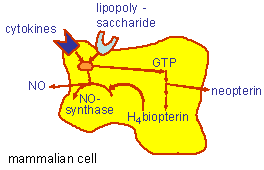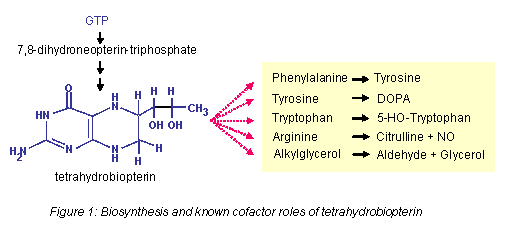Research Topics, Division of Biological Chemistry, Biocentre, Innsbruck Medical University

Pteridine biosynthesis and NO formation in mammalian cells, see text below for more information.
Follow link for >>neopterin and immunological activity monitoring.
Small molecules with central metabolic functions
Neopterin is a product of human monocyte-derived macrophages (1) and dendritic cells(2) formed preferentially in response to interferon-γ but also to some other pro-inflammatory stimuli. It stems from 7,8-dihydroneopterin-triphosphate, a metabolite in the formation of 5,6,7,8-tetrahydrobiopterin (H4-biopterin) from GTP. H4-biopterin is a cofactor for hydroxylating aromatic amino acids – and is hence of crucial importance for neurotransmitter formation –, for nitric oxide (NO) formation from L-arginine – a key molecule for neurotransmission, blood pressure regulation and immune function –, and for alkylglycerol (glyceryl-ether) monooxygenase (Figure 1).

Earlier work of our group characterized various cell types and immune stimuli for increased H4-biopterin formation (3) and we showed for the first time that intracellular H4-biopterin levels control cytokine-induced and constitutive NO formation (4, 5). A major achievement was also our contribution to clarifying the molecular mechanism by which H4-biopterin catalyses NO formation from L-arginine, which is essentially different from that found in aromatic amino acid hydroxylases since only one electron is donated and a pterin-radical is formed (6). In the following, the relationship of endogenous H4-biopterin levels and its interplay with NO synthases, peroxynitrite and superoxide was investigated showing that suboptimal cofactor levels lead to formation of radicals involved in tissue damage (7, 8). Radical formation is reduced by ascorbic acid (9) or by trolox, a tocopherol derivative, due to stabilizing H4-biopterin and thus preventing superoxide formation by impaired NO synthase function (10). On the other hand, neopterin is able to amplify deleterious effects of radicals in various cellular systems and seems part of the pro-inflammatory and cytocidal armature of the activated human macrophage (11). Our identification of the sequence of alkylgylcerol monooxygenase (12) will help to clarify the contribution of ether lipid degradation to pterin metabolism-related physiological effects.
- Huber, C., Batchelor, J. R., Fuchs, D., Hausen, A., Lang, A., Niederwieser, D., Reibnegger, G., Swetly, P., Troppmair, J., Wachter, H. (1984) Immune response-associated production of neopterin. Release from macrophages primarily under control of interferon-gamma. J.Exp.Med. 160: 310-316
- Wirleitner B, Reider D, Ebner S, Böck G, Widner B, Jaeger M, Schennach H, Romani N, Fuchs D (2002) Monocyte-derived dendritic cells release neopterin. J Leukocyte Biol 72:1148-1153
- Werner ER, Gorren ACF, Heller R, Werner-Felmayer G, Mayer B (2003) Tetrahydrobiopterin and nitric oxide: Mechanistic and pharmacological aspects. Exp Biol Med 228:1291-1302
- Werner-Felmayer G, Werner ER, Fuchs D, Hausen A, Reibnegger G, Wachter H (1990) Tetrahydrobiopterin-dependent formation of nitrite and nitrate in murine fibroblasts.J Exp Med 172:1599-1607
- Werner-Felmayer G, Werner ER, Fuchs D, Hausen A, Reibnegger G, Schmidt K, Weiss G, Wachter H (1993) Pteridine biosynthesis in human endothelial cells. Impact on nitric oxide-mediated formation of cyclic GMP. J Biol Chem 268:1842-1846
- Schmidt PP, Lange R, Gorren ACF, Werner ER, Mayer B, Andersson KK (2001) Formation of a protonated trihydrobiopterin radical cation in the first reaction cycle of neuronal and endothelial nitric oxide synthase detected by electron paramagnetic resonance spectroscopy. J Biol Inorg Chem 6:151-158
- Cosentino F, Patton S, d'Uscio LV, Werner ER, Werner-Felmayer G, Moreau P, Malinski T, Luscher TF (1998) Tetrahydrobiopterin alters superoxide and nitric oxide release in prehypertensive rats. J Clin Invest 101:1530-1537
- Pfeiffer S, Gorren ACF, Schmidt K, Werner ER, Hansert B, Bohle DS, Mayer B (1997) Metabolic fate of peroxynitrite in aqueous solution. Reaction with nitric oxide and pH-dependent decomposition to nitrite and oxygen in a 2:1 stoichiometry. J Biol Chem 272:3465-3470
- Heller R, Unbehaun A, Schellenberg B, Mayer B, Werner-Felmayer G, Werner ER (2001) L-Ascorbic acid potentiates endothelial nitric oxide synthase via a chemical stabilization of tetrahydrobiopterin. J Biol Chem 276:40-47
- Heller R, Hecker M, Stahmann N, Thiele JJ, Werner-Felmayer G, Werner ER (2004) Alpha-tocopherol amplifies phosphorylation of endothelial nitric oxide synthase at serine 1177 and its short chain derivative trolox stabilizes tetrahydrobiopterin. Free Rad Biol Med 37:620-631
- Hoffmann G, Wirleitner B, Fuchs D (2003) Potential role of immune system activation associated production of neopterin derivatives in humans. Inflammation Res 52:313-321
- Watschinger, K., Keller, M. A., Golderer, G., Hermann, M., Maglione, M., Sarg, B., Lindner, H. H., Hermetter, A., Werner-Felmayer, G., Konrat, R., Hulo, N., Werner, E. R. (2010) Identification of the gene encoding alkylglycerol monooxygenase defines a third class of tetrahydrobiopterin-dependent enzymes. Proc.Natl.Acad.Sci.U.S.A 107:13672-7



